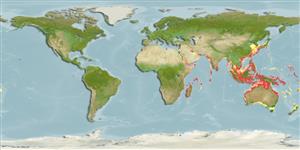Common names from other countries
>
Syngnathiformes (Pipefishes and seahorses) >
Centriscidae (Snipefishes and shrimpfishes) > Centriscinae
Etymology: Centriscus: Derived from Greek, kentris, -idos = sting (Ref. 45335).
More on author: Linnaeus.
Environment: milieu / climate zone / depth range / distribution range
Ecologia
marinhas; estuarina associadas(os) a recifes; intervalo de profundidade 2 - 100 m (Ref. 37816), usually 2 - 15 m (Ref. 90102). Tropical; 34°N - 35°S, 32°E - 172°E
Indo-Pacific: Red Sea and Arabian Gulf (Ref. 11441) to New Guinea, north to southern Japan, south to New South Wales, Australia.
Tamanho / Peso / Idade
Maturity: Lm ? range ? - ? cm
Max length : 17.0 cm TL macho/indeterminado; (Ref. 110387)
Espinhos dorsais (total) : 3; Raios dorsais moles (total) : 10 - 12; Raios anais moles: 11 - 12. Silvery with reddish brown to blackish mid-lateral stripe. Main dorsal spine moderately long and without joint (Ref. 48635).
Inhabits sandy or muddy floors of shallow inlet waters. Usually in large schools among branching corals, seawhip gardens and black coral bushes to about 15 m depth. Small juveniles in surface waters and sometimes in small groups along beach edges in quiet bays and settle with crinoids or urchins (Ref. 48635). Usually processed into fishmeal (Ref. 2858).
Life cycle and mating behavior
Maturities | Reprodução | Spawnings | Egg(s) | Fecundities | Larvas
Masuda, H., K. Amaoka, C. Araga, T. Uyeno and T. Yoshino, 1984. The fishes of the Japanese Archipelago. Vol. 1. Tokai University Press, Tokyo, Japan. 437 p. (text). (Ref. 559)
Categoria na Lista Vermelha da IUCN (Ref. 130435)
CITES (Ref. 128078)
Not Evaluated
Ameaça para o homem
Harmless
Utilização humana
Pescarias: espécies comerciais; Aquário: Espécies comerciais
Ferramentas
Relatórios especiais
Descarregue XML
Fontes da internet
Estimates based on models
Preferred temperature (Ref.
115969): 24.8 - 29.3, mean 28.4 (based on 3743 cells).
Phylogenetic diversity index (Ref.
82804): PD
50 = 0.7502 [Uniqueness, from 0.5 = low to 2.0 = high].
Bayesian length-weight: a=0.00282 (0.00106 - 0.00750), b=3.10 (2.86 - 3.34), in cm Total Length, based on LWR estimates for this (Sub)family-body shape (Ref.
93245).
Nível Trófico (Ref.
69278): 3.3 ±0.4 se; based on size and trophs of closest relatives
Resiliência (Ref.
120179): Elevada, tempo mínimo de duplicação da população menor que 15 meses (Preliminary K or Fecundity.).
Fishing Vulnerability (Ref.
59153): Low vulnerability (10 of 100).
